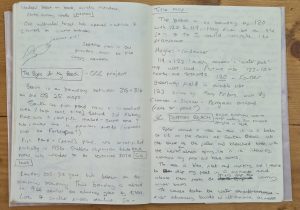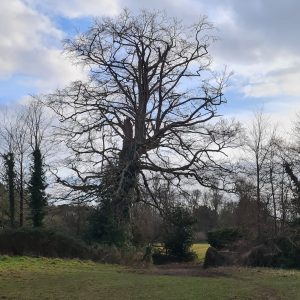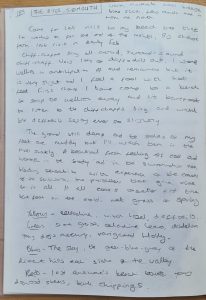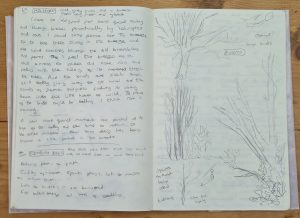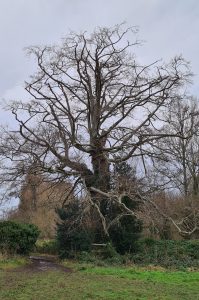This month (March 2022) I have been working on a large-scale piece for an exhibition focusing on trees in Sidmouth, a town local to me. Many of you may have seen images of this piece coming together on Instagram. This piece, pictured below, is my first attempt at using nature journaling to inform larger work for framing and hanging rather than as a book form. This artwork is a single-page nature journal that visually documents several visits to the tree between January and March and the wildlife I saw in and around it, plus some of the history relating to the tree’s position. I incorporated photos taken of the tree from different angles, images of plants and birds seen around the base of the tree, and a map that is a combination of two old maps (from the 1840s and 1880s) and associated documentation.
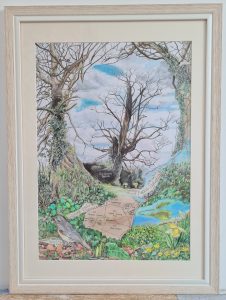
I have been working on this alongside the 2022 Daily Nature Journal project for the last few months. My first nature journaling visit to the general location I was interested in was on January 9th. My favourite sight of the day was a redwing flicking through the leaf litter in just the same way as its relative the blackbird does. Immediately, I made the decision that a redwing would feature in the work no matter what tree I chose to represent. Walking a little further, I found the tree and immediately knew, based on its sprawling shape and interesting position next to a very deliberate gap in a boundary bank, that I had the tree I wanted to focus on. I then went back to the studio and began to plan the piece based on these first observations.
In the studio, I was starting to think about the map and was doing research into where the old field boundaries lay. I have been using maps as a major part of my nature journaling for a while now. I found that the tree was on the intersection of three fields in the 1840s map, but only two in the 1880s. It was a tree grown large to mark the path between the fields and its large roots cover the end of a long bank.
I went back for a second visit at the end of January, seeking to I took a much wider set of photos, looking up into the branches from all angles and looking back at the tree from several different directions. I took my nature journal along to scribble down the mood of the day and any observations.
The third nature journaling visit was on a slightly brighter day in February. Once some better weather arrived, I headed straight out to see the tree against a different sky as I had only seen it under a bleak white blanket of cloud. I captured some more images, focusing much more on some of the finer details; the buds of the lower branches, the start of bulbs, and arum leaves starting to unfurl at the tree base.
On the final visit before the exhibition, I still had a troublesome empty bottom corner, and thus more memories of the tree to find and form, before I could call the piece finished. By this time, it was mid-March and there were carpets of celandine forming, daffodils everywhere, and the very first leaves starting to come out. The problem of the bottom corner was solved by the sight of so much yellow near the tree and the entire piece was finished shortly after.
In the process of creating this piece, I had four days of observations with my outdoor nature journal and camera, plus plenty of research time to find out about the tree. The final work was a combination of all those memory-forming visits to build an overall understanding of the character of the tree, the lives it supports, and the history of the land it stood upon.
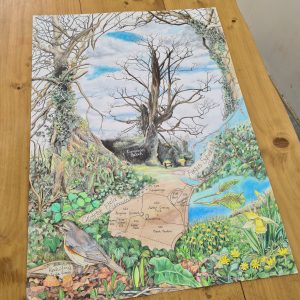
In the process of creating this piece, I had four days of observations with my outdoor nature journal and camera, plus plenty of research time to find out about the tree. The final work was a combination of all those memory-forming visits to build an overall understanding of the character of the tree, the lives it supports, and the history of the land it stood upon.
All of this could have been expanded further, perhaps over the course of a year (or several), but the period of winter into early spring has enough interest to inform one artwork or many nature journal pages.
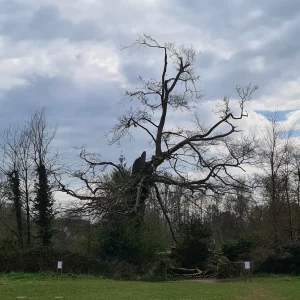
And all of this time and effort turned out to be particularly valuable because the day of the hanging of this piece in the exhibition, strong winds from the north-east whistled down the valley. The tree, hollow with age and heavily buttressed for the typical south-westerly winds, was toppled. Suddenly, and quite dramatically, I was reminded of how nature journaling is an activity that preserves memories, capturing moments in time in words and image. That’s a particularly important thing for nature because it is a dynamic process, ever changing, sometimes very dramatically! By working in our nature journals, we are tying down some of those moments and also adding another dimension of recording how we respond emotionally to what we are seeing.
See images from the Sidmouth Byes exhibition, including this tree, at Sidmouth Museum in 2024.
Limited-edition prints of the Sidmouth Byes tree piece, “Hedgerow Beech in Gilchrist Field” are available in my webshop.




